By Jennifer Whitlock
Field Editor
Researchers at Texas A&M University received a $500,000 grant from the U.S. Department of Agriculture (USDA) National Institute of Food and Agriculture (NIFA) to investigate stocking density in beef heifers raised in drylots.
Although drylots are not a common feature in the Texas landscape, they likely will be in the future as Texas urbanization continues to accelerate. And it’s best to be prepared, said Texas A&M Beef Cattle Production Associate Professor Dr. Reinaldo Cooke.
“Houston, Navasota and College Station will soon become one big metropolitan area. We are going to have less grass resources for cattle, competing with urban development and crop production,” Cooke told AgriLife Today. “I don’t believe the whole industry will change to confined operations, but we need to find management systems to make sure we are maintaining or promoting production efficiency and fostering animal welfare.”
Replacement heifers from spring-calving herds are usually weaned in the fall and bred the following spring when they’re about 15 months old. In the western portion of the U.S., Cooke noted heifers are frequently moved to drylots in the winter at about seven to nine months of age to ensure they are fed appropriately for optimal growth.
Earlier studies conducted by Cooke found beef heifers moved into drylots had lower reproductive efficiencies than expected, however.
There is no clear guidance on the issue, as current confined stocking recommendations are generally aimed at feedlot or dairy cattle and not cow-calf operations. And density guidelines for feedlots haven’t been updated since the 1980s, he added.
Cooke, along with Drs. Rodolfo Cardoso, Courtney Daigle, Cliff Lamb and Ky Pohler, will study how stocking density may affect heifer reproductive health and development.
“Every time we have heifers enclosed in a confined environment, their reproduction efficiency is less than heifers in open pasture that had a lower quality diet,” he said. “The drylot heifers gained more weight with better food, but not reproductive efficiency.”
The researchers’ working theory is that heifers raised in drylots don’t have as much room or opportunity to move around, which somehow affects hormonal production. The study will determine if providing areas for voluntary exercise and more loafing space negates the effects of drylot housing on reproduction efficiency.
The team is basing their theory on studies in dairy farms showing cows with voluntary exercise opportunities had positive outcomes in wellbeing and productivity. Cooke said he expects to see similar results in reproductive responses among drylot heifers.
In addition to providing exercise space, Cooke and his colleagues will compare different stocking densities. Accommodating larger group sizes with more space may alleviate social stressors among herds and promote physical activity, he noted.
“We will have exercising, 30 minutes a day and non-exercising heifers to determine if their reproductive inefficiency is a fact of being confined or the lack of exercise,” he said. “Our second and third objectives will look at stocking densities–how many animals in the pens.”
The Federation of Animal Science Societies recommends around 15 square yards per heifer in unpaved drylots. Cooke said they will start with the minimum space suggested and work up to where they reach the same reproductive efficiency levels as heifers raised on pasture.

